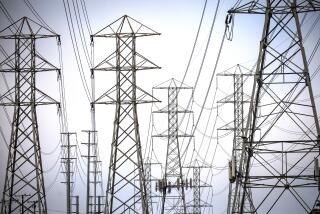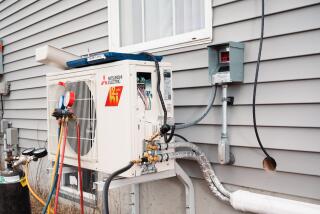Curbing Energy Flow Can Bolster Cash Flow
- Share via
Saving energy is still one of the best ways to save money. Here are some tips:
* Controlling your thermostat is a tried-and-true money saver. Set your thermostat to 68 degrees in winter and 78 degrees in summer. It costs nothing to do, and you save from 2% to 3% of your heating and cooling costs for each degree of change.
* Or install a programmable setback thermostat. You can set it to automatically turn down the thermostat at night or when you leave the house for the day, or to shut off the air conditioner when you’re away.
* Control drafts. Pull drapes over windows to make the house warmer. In summer, shade the windows from the sun with awnings to keep the house cooler.
Furnace, Water Heater
* Change the furnace filter often. A filter protects the blower motor from dust and dirt so it will last longer. When the filter becomes clogged, the airflow through the heating and cooling ducts is reduced, causing the motor to work harder. Buy a half-dozen filters at a time from a home center. Routinely replace the filter every one to three months.
* Blanket your water heater. A typical 40- to 60-gallon tank of an older home water heater continually gives off heat that’s wasted. Buy a fiberglass blanket to wrap around the heater. But . . .
* Be cautious. Don’t insulate the top of a gas water heater. And don’t cover the air intakes of gas burners at the bottom. Don’t cover any controls, valves or warning labels. Many newer, super-insulated, high-efficiency water heaters don’t need extra insulation; adding it can even void the guarantee. Check your owner’s manual.
Shower Head
* Replace your shower head with a restricted-flow model. From 10% to 20% of energy loss goes down the drain as hot water. About half of that is from the shower. Convert from a 5-gallons-per-minute shower head to a 2 1/2-gallon model. You’ll use less hot water and save the heating costs.
* Some older shower heads don’t put out a full 5 gallons per minute because of clogging or low water pressure. To check yours, turn the shower on and fill a bucket for exactly 30 seconds. Then measure the amount of water and double the total to find the shower’s output per minute. If it measures about 5 gallons per minute, convert the shower head to a low-flow model.
Duct Control
* Seal around air ducts on forced-air heating and cooling systems. Large amounts of energy--from 10% to 40%--are lost from heated or cooled air leaking from air duct joints.
* Ducts generally run in hard-to-reach areas. You may have to pull back insulation for access to the joints. To seal small cracks, use tubes of silicone caulk or special duct sealant available from heating supply stores.
* For larger gaps, apply the same type of fiberglass mesh tape as that used for drywall construction. Spread duct sealant over the tape with a putty knife. For greatest economy, buy the sealant in 1-gallon cans. The duct tape that is commonly used to seal such joints is only a temporary solution.
* When sealing ducts in an attic, lay plywood or planks over the joists so that you don’t slip off and damage the ceiling below.
More to Read
Inside the business of entertainment
The Wide Shot brings you news, analysis and insights on everything from streaming wars to production — and what it all means for the future.
You may occasionally receive promotional content from the Los Angeles Times.










